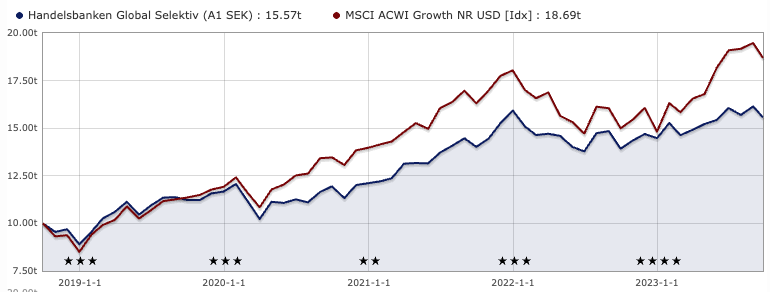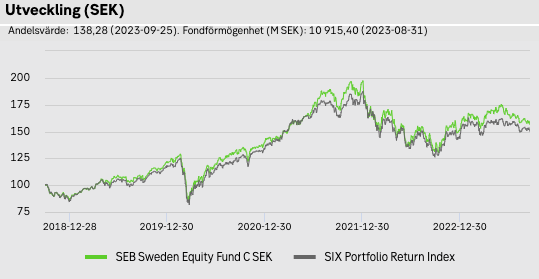NOT FINANCIAL ADVICE
The information contained on this site and the resources available for download through this website is not intended as, and shall not be understood or construed as, financial advice. I am not an attorney, accountant or financial advisor, nor am I holding myself out to be, and the information contained on this website is not a substitute for financial advice from a professional who is aware of the facts and circumstances of your individual situation. In exchange for using the site, you agree not to hold FinancialLiteracy.se, its affiliates or any third party service provider liable for any possible claim for damages arising from any decision you make based on information or other content made available to you through the site.
INVESTMENT RISKS
There are risks associated with investing in securities. Investing in stocks, bonds, exchange traded funds, mutual funds, and money market funds involve risk of loss. A security’s or a firm’s past investment performance is not a guarantee or predictor of future investment performance.
Wanna know which banks to leverage for you investments? Where the fees are lowest and the offering is the best? Then this post is for you.
As I’ve allured to in previous posts, there are better and worse options in Sweden when it comes to investment banks. Most of you probably already have a checking account (🇸🇪 lönekonto) with any of the 4 major banks in Sweden:
- Nordea
- Handelsbanken
- Swedbank
- SEB
And most likely they’ve tried to convince you to open an investment account with them too? Perhaps even succeeded? Well, don’t worry, we’re about to fix that. Because there are far better options out there, namely:
- Avanza
- Nordnet
These two “online banks” (no physical offices) beat the 4 major banks of Sweden both in terms of offering and fees. Let’s have a look.
Fees
Fees are quintessential when you’re looking to invest your money. Since almost all fees are charged as a % of your total holding in a specific fund, it can get really expensive, really fast. That’s why keeping fees at a minimum should be at the core of your passive investment strategy. In order to learn more about fees, 🇸🇪 normanbelopp and how to understand compounding interest with regards to fees, please read this post first and then come back here 🙏🏼
You done? You throughly appalled at how much of your money goes into the pockets of fund managers? Me too. Then let’s continue by having a look at the fee distribution of the 4 big banks of Sweden.
According to Finansinspektionen the median fees for index funds (not actively managed, but instead tracking an index) and actively managed funds looked like this in Q1 2023:
| Sweden | Fee (%) | Global | Fee (%) |
|---|---|---|---|
| Index | 0.28 | Index | 0.4 |
| Actively managed | 1.34 | Actively managed | 1.35 |
To clarify, 1.34% is the median fee for an actively managed fund focusing on the Swedish market. Median! That means that there are just as many funds that are even more expensive, as there are cheaper ones. And as you might recall from the post about fees, a fee of 1.15% already robs you of 20%+ of your investment on a 30 year investment timeline. At 1.34% the math will be even worse.
So, what do the fund fees look like at Sweden’s biggest banks? Let’s have a look at their recommended and “favourite” funds (the ones they’re most likely to recommend to you). We’ll look at some actively managed funds (global and Sweden focused) as well as some index versions. We’ll also have a look at whether the actively managed versions have a track record of outperforming their corresponding index.
Nordea
Nordea offers a chart of popular choices of funds among their customers. We’ll look at 2 actively managed funds from the “Monthly Savings Favourites” and 1 actively managed fund from the “Equity Fund Favourites”, as well as 2 index funds.
| Fund | Market | Type | Fee (%) |
|---|---|---|---|
| Nordea Stratega 50 (no 1 on “Monthly Savings Favourite”) | Global | Active | 1.42 |
| Nordea Stratega 60 (no 2 on “Monthly Savings Favourite”) | Global | Active | 1.47 |
| Nordea Global Passiv (no 4 on “Equity Fund Favourites”) | Global | Index | 0.40 |
| Nordea Swedish Stars (no 1 on “Equity Fund Favourites”) | Sweden | Active | 1.40 |
| Nordea Institutionella Aktiefonden Sverige | Sweden | Index | 0.50 |
Below I’ll insert the performance of the 2 globally focused actively managed funds over the past 5 years, compared to their corresponding index. The Sweden focused Nordea Swedish Stars hasn’t been around long enough for a 5 year comparison, hence it’s not included. As you can tell by the graphs below (which are from Nordea’s own website), none of the actively managed funds appear to consistently (or even occasionally) be outperforming their index on a 5 year timeline.
Nordea Stratega 50

Nordea Stratega 70

Handelsbanken
At Handelsbanken we’ll look at 2 actively managed funds and 2 index ones, with the market focus being global and Sweden.
| Fund | Market | Type | Fee (%) |
|---|---|---|---|
| Handelsbanken Global Selektiv | Global | Active | 1.60 |
| Handelsbanken Global Index Criteria | Global | Index | 0.40 |
| Handelsbanken Sverige Selektiv | Sweden | Active | 1.85 |
| Handelsbanken Sverige Index Criteria | Sweden | Index | 0.65 |
Below I’ll insert the performance of the 2 actively managed funds over the past 5 years, compared to their corresponding index. As you can tell by the graphs below (which are from Morningstar), only the Sweden focused actively managed fund appears to occasionally outperform it’s index on a 5 year timeline.
Handelsbanken Global Selektiv

Handelsbanken Sverige Selektiv

Swedbank
At Swedbank we’ll look at 2 actively managed funds and 2 index ones, with the market focus being global and Sweden.
| Fund | Market | Type | Fee (%) |
|---|---|---|---|
| Swedbank Robur Globalfond Aktiv | Global | Active | 1.26 |
| Swedbank Robur Access Global | Global | Index | 0.21 |
| Swedbank Robur Sverige | Sweden | Active | 1.25 |
| Swedbank Robur Access Sverige | Sweden | Index | 0.20 |
Below I’ll insert the performance of the 2 actively managed funds over the past 5 years, compared to their corresponding index. As you can tell by the graphs below (which are from Morningstar), only the globally focused actively managed fund appears to occasionally outperform it’s index on a 5 year timeline.
Swedbank Robur Globalfond Aktiv

Swedbank Robur Sverige

SEB
SEB curates a “main” fund portfolio and also a recommended list, so we’ll be looking at a few of those funds. Again with the explicit focus being either Sweden or global and also both index and actively managed.
| Fund | Market | Type | Fee (%) |
|---|---|---|---|
| SEB Global Aktiefond | Global | Active | 1.50 |
| SEB Global Indexnära D USD | Global | Index | 0.45 |
| SEB Sweden Equity Fund C | Sweden | Active | 1.30 |
| SEB Sverige Indexnära | Sweden | Index | 0.25 |
Below I’ll insert the performance of the 2 actively managed funds over the past 5 years, compared to their corresponding index. As you can tell by the graphs below (which are from SEBs website), only the Sweden focused actively managed fund appears to occasionally outperform it’s index on a 5 year timeline.
SEB Global Aktiefond

SEB Sweden Equity Fund C

Conclusion
The median fee for actively managed funds in Q1 2023 according to Finansinspektionen was 1.34% (Sweden) and 1.35% (Global). Only 3 (!) funds mentioned in this review have a fee lower than the median and not by much: SEB Sweden Equity Fund C (1.30%), Swedbank Robur Globalfond Aktiv (1.26%) and Swedbank Robur Sverige (1.25%). That’s not a good look in my opinion. And Handelsbanken sure stands out with their positively astronomical fees of 1.85% (!) for Handelsbanken Sverige Selektiv and 1.60% for Handelsbanken Global Selektiv.
The alternative
Now, let’s look at what an equivalent index fund would cost you at Avanza or Nordnet. Why only index funds? Because it’s been proven again and again that actively managed funds seldom, if ever, outperform their index when you take the astronomical fees into account (which one always should!). So therefor, we’ll be looking at which cheap index funds you could be buying instead of giving your money away to fund managers at Nordea, Handelsbanken, Swedbank or SEB.
Avanza
Avanza offers the following 2 global/Sweden focused index funds:
| Fund | Market | Type | Fee (%) |
|---|---|---|---|
| Avanza Zero | Sweden | Index | 0.00 |
| Avanza Global | Global | Index | 0.09 |
Nordnet
Nordnet offers the following 2 global/Sweden focused index funds:
| Fund | Market | Type | Fee (%) |
|---|---|---|---|
| Nordnet Indexfond Sverige ESG | Sweden | Index | 0.00 |
| Nordnet Indexfond Global ESG | Global | Index | 0.20 |
Conclusion
Avanza and Nordnet offer index funds at extremely competitive prices. There’s really no reason, at all, to be investing your hard earned money with the 4 big banks of Sweden, as their fund fees are positively astronomical, even for passive index funds!
Offering
Now, there’s one more aspect I said we should look at, and that was the offering. Perhaps the offering is at least the same regardless of which bank you choose? Wrong. The amount of funds you can choose between differs massively from bank to bank. Let’s have a look, first at the 4 big banks in Sweden:
- SEB: 465 funds, full list here.
- Swedbank: 300 funds, full list here.
- Nordea: 160 funds, partial list here, full list not available online.
- Handelsbanken: 1085 funds, full list here.
Then let’s look at the two competing banks:
- Avanza: 1350 funds
- Nordnet: 1645 funds
Final thoughts
When looking at the fees and the offering, I hope that where to put your hard earned money no longer feels like a hard choice 😉


Excellent article Kim, thanks a lot. Could you please explain more about Nordnet Indexfond Sverige ESG and its effective interest rate?
Hey, thanks for writing this. I felt it easy to follow along and understand the point. Continued writing, good luck!